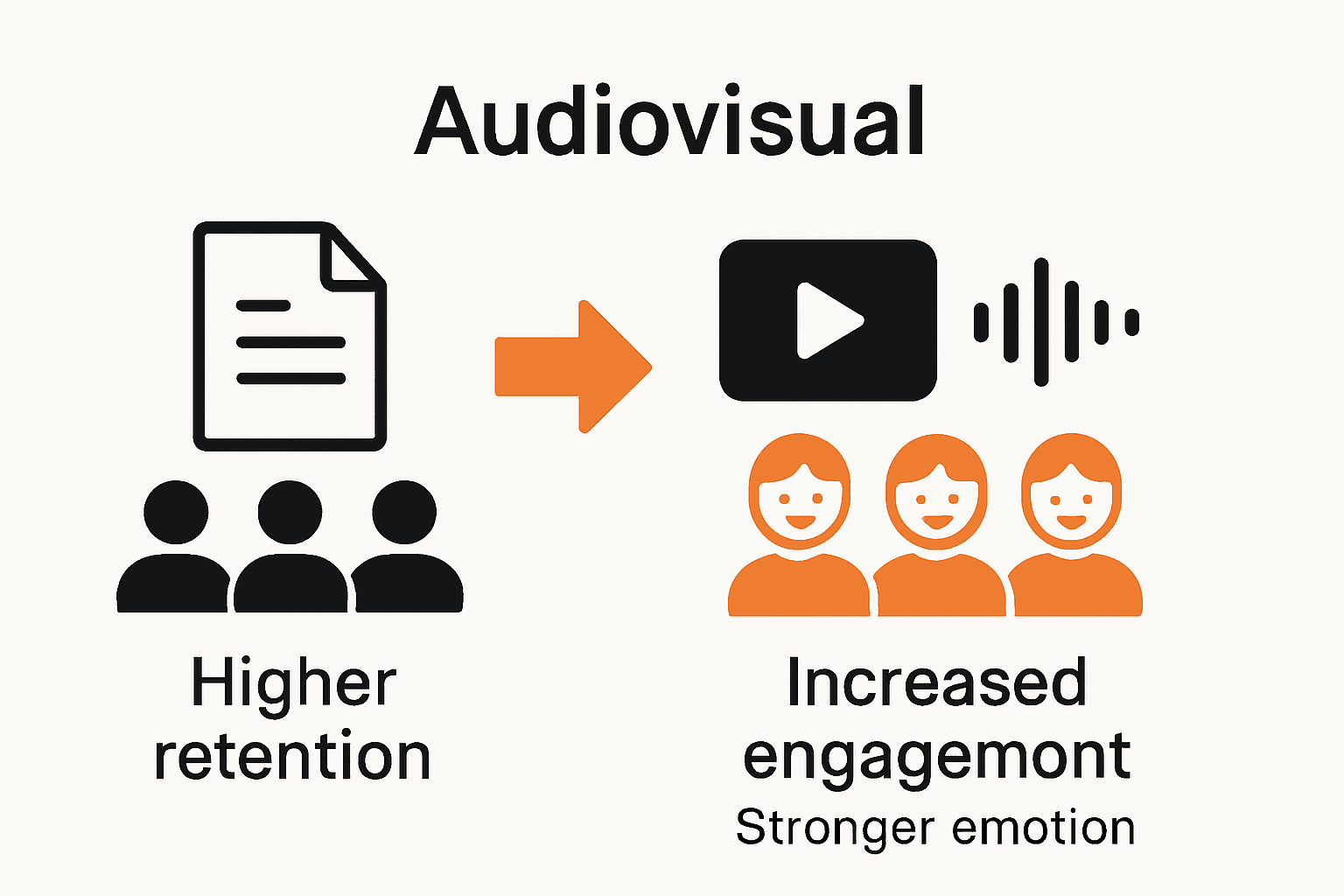Understanding What is Audiovisual Marketing and Its Impact
- Pieter Nijssen
- Oct 14
- 8 min read

Audiovisual marketing has become a powerhouse for brands looking to stand out and leave a lasting impression. Big surprise, people remember visuals and sound together far better than ordinary text – in fact, the human brain processes visual info 60,000 times faster than text. Most people expect video to just entertain, but the real magic is in emotional impact. Audiovisual storytelling is rapidly redefining how businesses connect, turning every message into an experience you cannot ignore.
Table of Contents
Quick Summary
Takeaway | Explanation |
Audiovisual marketing enhances message retention. | Combining visual and audio elements improves how audiences remember the communicated messages. |
Emotional connections drive audience engagement. | Compelling storytelling through audiovisual content creates strong emotional ties with viewers, prompting them to engage with the brand. |
Successful strategies tailor content for digital platforms. | Utilizing short, engaging formats suitable for mobile consumption increases effectiveness in capturing audience attention. |
Advanced technologies enhance audiovisual capabilities. | Innovations like AI and AR allow for more dynamic and personalized content experiences, improving audience interaction. |
Precision in messaging appeals to Swiss audiences. | High-quality audiovisual content reflects reliability and innovation, essential for effectively positioning brands in the Swiss market. |
Defining Audiovisual Marketing: Key Components
Audiovisual marketing represents a strategic communication approach that combines visual and audio elements to create compelling narrative experiences for audiences. According to research from ResearchGate, this method leverages synchronized sight and sound to enhance message retention and emotional impact.
Core Visual and Audio Elements
At its foundation, audiovisual marketing integrates multiple sensory channels to communicate brand stories. Visual components include graphics, video footage, animations, and imagery that capture audience attention. Audio components encompass music, voiceovers, sound effects, and spoken narratives that complement visual messages.
Key visual and audio integration strategies involve:
Creating harmonious relationships between visual and auditory elements
Ensuring synchronized messaging across different media platforms
Designing content that evokes specific emotional responses
To help clarify the main elements that make up audiovisual marketing, the table below breaks down the key visual and audio components alongside their purposes.
Element | Examples | Purpose |
Visual | Graphics, video footage, animations, imagery | Capture audience attention and visually tell the story |
Audio | Music, voiceovers, sound effects, narration | Complement visuals, provide emotional resonance |
Synchronization | Coordinated timing of sight and sound | Enhance message clarity and memorability |
Emotional Triggers | Selected imagery and music | Elicit specific feelings and drive engagement |
Strategic Communication Approach
Brands utilize audiovisual marketing to transform complex information into engaging storytelling experiences. By combining multiple sensory inputs, organizations can communicate more effectively, creating deeper connections with target audiences. Learn more about our audiovisual storytelling techniques to understand how professional production elevates communication strategies.
The most successful audiovisual marketing strategies focus on creating authentic, memorable experiences that resonate with viewers through carefully crafted visual and audio narratives. This approach goes beyond traditional advertising by building emotional engagement and brand recognition through immersive, multi-sensory content.
The Importance of Audiovisual Marketing for Businesses
Businesses today recognize audiovisual marketing as a powerful communication strategy that transcends traditional advertising methods. According to Forbes research, visual content generates significantly higher engagement rates compared to text-based communications.

Enhanced Brand Communication and Engagement
Audiovisual marketing provides businesses with a dynamic platform to communicate complex messages effectively. By combining visual and auditory elements, companies can create memorable brand experiences that resonate deeply with target audiences. Compelling storytelling through multimedia content allows organizations to:
Build emotional connections with potential customers
Simplify complex product or service explanations
Showcase brand personality and unique value propositions
Competitive Advantage in Digital Landscape
In an increasingly digital marketplace, businesses that leverage audiovisual marketing gain substantial competitive advantages. Discover why investing in video content can transform your marketing strategy. Organizations using sophisticated audiovisual techniques can differentiate themselves by creating immersive, engaging content that captures audience attention more effectively than traditional marketing approaches.
Strategic audiovisual marketing enables businesses to communicate authentically, build trust, and establish stronger connections with their target demographics. By presenting information through visually compelling narratives, companies can transform passive viewers into active, engaged potential customers who are more likely to remember and act upon their marketing messages.
The following table compares traditional marketing to audiovisual marketing, highlighting how audiovisual approaches offer distinct advantages for businesses.
Aspect | Traditional Marketing | Audiovisual Marketing |
Communication Style | Text-heavy, static images | Integrated visuals and audio for storytelling |
Emotional Engagement | Limited, relies on copywriting | High, utilizes music and moving imagery |
Information Retention | Lower, slower processing | Higher, faster processing (60,000x faster) |
Audience Interaction | One-way, passive | Two-way, immersive, multisensory |
Platform Adaptability | Often fixed, print/digital | Highly versatile across digital/mobile platforms |

How Audiovisual Content Engages Audiences
Audiovisual content transforms audience engagement by creating immersive, multi-sensory experiences that capture attention and stimulate emotional responses. According to neuroscience research from Oxford University, synchronized visual and audio inputs activate multiple neural pathways, enhancing information processing and retention.
Psychological Mechanisms of Engagement
Emotional connection lies at the core of audiovisual content’s effectiveness. By integrating visual storytelling with compelling audio elements, brands can trigger powerful psychological responses. The human brain processes visual information 60,000 times faster than text, making multimedia content an incredibly potent communication tool. Key engagement mechanisms include:
Creating narrative arcs that resonate with audience experiences
Utilizing emotional triggers through carefully selected imagery and sound
Generating sensory experiences that feel personal and authentic
Multisensory Communication Strategies
Successful audiovisual content leverages the brain’s complex processing capabilities by stimulating multiple sensory channels simultaneously. Explore our guide on visual storytelling techniques to understand how professional content creators craft engaging narratives. By synchronizing visual aesthetics with carefully curated soundscapes, brands can create memorable experiences that transcend traditional communication boundaries.
The most effective audiovisual content does more than inform—it creates an emotional journey that connects viewers with the underlying message, transforming passive observation into active engagement and potentially driving meaningful audience action.
Trends in Audiovisual Marketing: What to Know
The audiovisual marketing landscape is rapidly evolving, driven by technological advancements and changing consumer preferences. According to Statista research on European online video content, digital video consumption continues to grow exponentially, reshaping how brands communicate with audiences.
Emerging Content Formats
Digital video platforms are transforming audiovisual marketing strategies, introducing innovative content approaches that capture audience attention. Contemporary trends emphasize short-form, highly engaging content that delivers messages quickly and effectively. Key emerging formats include:
Vertical video optimized for mobile consumption
Interactive and immersive storytelling experiences
User-generated content integrated with brand narratives
Technology-Driven Marketing Innovations
Advanced technologies are redefining audiovisual marketing capabilities. Artificial intelligence, augmented reality, and personalization algorithms are enabling more targeted and dynamic content experiences. Explore our strategic video marketing guide for 2025 to understand how cutting-edge technologies are revolutionizing brand communication.
The most successful audiovisual marketing strategies now focus on creating adaptive, personalized content experiences that respond to individual viewer preferences. By leveraging data-driven insights and emerging technologies, brands can develop more authentic, engaging multimedia narratives that resonate deeply with modern audiences.
Real-World Applications of Audiovisual Marketing in Switzerland
Switzerland represents a sophisticated market where audiovisual marketing has become an essential communication strategy across multiple sectors. According to Swiss national branding research, multimedia storytelling plays a critical role in showcasing national innovation and economic strengths.
Industry-Specific Audiovisual Strategies
Swiss businesses leverage audiovisual marketing across diverse sectors, demonstrating remarkable adaptability and precision. Strategic multimedia communication allows companies to highlight unique value propositions and connect with both domestic and international audiences. Key industry applications include:
Banking and financial services presenting complex investment concepts
Pharmaceutical companies explaining medical innovations
Technology firms showcasing intricate product functionalities
Tourism boards creating immersive destination experiences
Local and International Brand Positioning
Audiovisual content enables Swiss organizations to communicate their distinctive brand identities effectively. Explore our essential audiovisual branding guide for Swiss businesses to understand how local companies craft compelling narratives. The Swiss market particularly values high-quality, precise visual storytelling that reflects national characteristics of reliability, innovation, and excellence.
Successful Swiss audiovisual marketing strategies emphasize authenticity, technical precision, and emotional resonance. By transforming complex information into engaging multimedia experiences, organizations can effectively communicate their unique strengths while maintaining the exceptional standards associated with Swiss professional communication.
Elevate Your Brand With Powerful Audiovisual Storytelling
Is your business struggling to capture attention and make a lasting impression with your current marketing efforts? As described in our article, audiovisual marketing is the missing link when you need to simplify complex messages, strengthen brand communication, and emotionally engage your audience. Many Swiss businesses face the challenge of standing out in a fast-paced digital world. Tulip Films helps you overcome these pain points by crafting personalized, high-impact videos that combine rich visuals with compelling audio. Experience the benefits of professional audiovisual content designed for deeper connections and maximum audience retention.

Ready to turn viewers into loyal customers? Start your journey with a free consultation at Tulip Films and see how our team translates strategy into captivating corporate videos, promotional ads, and event footage tailored to your goals. Browse examples of our visual storytelling and discover why Swiss organizations partner with Tulip Films for effective brand growth. Visit www.tulipfilms.ch today to unlock the true potential of audiovisual marketing for your business.
Frequently Asked Questions
What is audiovisual marketing?
Audiovisual marketing is a communication strategy that combines visual and audio elements to effectively convey brand messages. To implement it, consider integrating videos, soundtracks, and graphics to create a compelling narrative that engages your audience.
How does audiovisual marketing enhance audience engagement?
Audiovisual marketing enhances engagement by creating immersive experiences that trigger emotional responses. Start by focusing on storytelling techniques that resonate with your audience, such as using relatable characters or scenarios in your content.
What are the key components of an effective audiovisual marketing strategy?
An effective audiovisual marketing strategy includes synchronized visual and audio elements, creative narratives, and a clear emotional focus. To develop yours, outline your brand’s story, identify target emotions, and select the right audiovisual tools to convey your message.
How can businesses measure the impact of their audiovisual marketing efforts?
Businesses can measure the impact of audiovisual marketing through metrics like engagement rates, viewer retention, and conversion rates. Track these metrics over a 30–60 day period after launching your campaign to evaluate its effectiveness and make necessary adjustments.
What trends should I consider in audiovisual marketing for the future?
Key trends in audiovisual marketing include short-form video content, interactive storytelling, and the use of advanced technologies like AI. Stay ahead by experimenting with these formats and investing in tools that allow for personalization in your marketing content.
How can I create emotional connections through audiovisual content?
To create emotional connections, focus on using relatable narratives and carefully chosen audio-visual elements that resonate with your audience’s experiences. Start by identifying the emotions you want to evoke and design your content to align with those themes.
Recommended